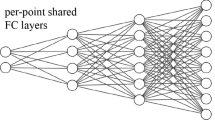Abstract
Radar sensors, unlike lidars or cameras, can measure objects’ instantaneous velocity and composition. However, the ability to process and retrieve spatial information from radar point clouds has not yet been fully established. In this work, we propose a key technique for improving the performance of standard machine learning point-wise processing methods on radar point clouds. We show that a network can learn to extract object-related signatures for every point using automotive radar measurements. In addition, we propose RadarPCNN, a novel architecture for performing semantic segmentation, specifically designed for radar point clouds. RadarPCNN uses PointNet++, aided with mean shift as feature extractor module and an attention mechanism to fuse information from different neighborhood levels. We show that our model outperforms state-of-the-art solutions on our dataset.
Access this chapter
Tax calculation will be finalised at checkout
Purchases are for personal use only
Similar content being viewed by others
References
Alessandretti, G., et al.: Vehicle and guard rail detection using radar and vision data fusion. IEEE Trans. Intell. Transp. Syst. 8(1), 95–105 (2007). https://doi.org/10.1109/TITS.2006.888597
Breiman, L.: Random forests. Mach. Learn 45(1), 5–32 (2001). https://doi.org/10.1023/A:1010933404324
Caesar, H., et al.: nuScenes: a multimodal dataset for autonomous driving. CoRR abs/1903.11027 (2019)
Engelcke, M., et al.: Vote3Deep: fast object detection in 3D point clouds using efficient convolutional neural networks. In: IEEE International Conference on Robotics and Automation, ICRA, pp. 1355–1361 (2017). https://doi.org/10.1109/ICRA.2017.7989161
Eriksson, L.H., As, B..: Automotive radar for adaptive cruise control and collision warning/avoidance. In: Radar 1997 (Conf. Publ. No. 449), pp. 16–20 (1997). https://doi.org/10.1049/cp:19971623
Ester, M., et al.: A density-based algorithm for discovering clusters in large spatial databases with noise. In: Proceedings of the Second International Conference on Knowledge Discovery and Data Mining (KDD-1996), pp. 226–231 (1996)
Feng, Y., et al.: GVCNN: group-view convolutional neural networks for 3D shape recognition. In: IEEE Conference on Computer Vision and Pattern Recognition, CVPR, pp. 264–272 (2018). https://doi.org/10.1109/CVPR.2018.00035
Feng, Z., et al.: Point cloud segmentation with a high-resolution automotive radar. In: 10th GMM-Symposium on Automotive meets Electronics, AmE 2019, pp. 1–5 (2019)
Fukunaga, K., Hostetler, L.D.: The estimation of the gradient of a density function, with applications in pattern recognition. IEEE Trans. Inf. Theory 21(1), 32–40 (1975). https://doi.org/10.1109/TIT.1975.1055330
Hochreiter, S., Schmidhuber, J.: Long short-term memory. Neural Comput. 9(8), 1735–1780 (1997). https://doi.org/10.1162/neco.1997.9.8.1735
Li, Y., et al.: PointCNN: convolution on x-transformed points. In: Advances in Neural Information Processing Systems 31: Annual Conference on Neural Information Processing Systems, NeurIPS, pp. 828–838 (2018)
Lin, T., et al.: Focal loss for dense object detection. In: IEEE International Conference on Computer Vision, ICCV, pp. 2999–3007 (2017). https://doi.org/10.1109/ICCV.2017.324
Prophet, R., et al.: Pedestrian classification for 79 GHz automotive radar systems. In: IEEE Intelligent Vehicles Symposium IV, pp. 1265–1270 (2018). https://doi.org/10.1109/IVS.2018.8500554
Qi, C.R., et al.: PointNet++: deep hierarchical feature learning on point sets in a metric space. In: Advances in Neural Information Processing Systems 30: Annual Conference on Neural Information Processing Systems, pp. 5099–5108 (2017)
Qi, C.R., et al.: PointNet: deep learning on point sets for 3D classification and segmentation. In: IEEE Conference on Computer Vision and Pattern Recognition, CVPR, pp. 77–85 (2017). https://doi.org/10.1109/CVPR.2017.16
Schumann, O., et al.: Semantic segmentation on radar point clouds. In: 21st International Conference on Information Fusion, FUSION, pp. 2179–2186 (2018). https://doi.org/10.23919/ICIF.2018.8455344
Shelhamer, E., et al.: Fully convolutional networks for semantic segmentation. CoRR abs/1605.06211 (2016)
Sultana, F., et al.: Advancements in image classification using convolutional neural network. CoRR abs/1905.03288 (2019)
Wöhler, C., et al.: Comparison of random forest and long short-term memory network performances in classification tasks using radar. In: Sensor Data Fusion: Trends, Solutions, Applications, SDF, pp. 1–6 (2017). https://doi.org/10.1109/SDF.2017.8126350
Yang, B., et al.: Attentional aggregation of deep feature sets for multi-view 3D reconstruction. CoRR abs/1808.00758 (2018)
Zaheer, M., et al.: Deep sets. In: Advances in Neural Information Processing Systems 30: Annual Conference on Neural Information Processing Systems, pp. 3391–3401 (2017)
Zhou, Y., Tuzel, O.: VoxelNet: end-to-end learning for point cloud based 3D object detection. In: IEEE Conference on Computer Vision and Pattern Recognition, CVPR, pp. 4490–4499 (2018). https://doi.org/10.1109/CVPR.2018.00472
Author information
Authors and Affiliations
Corresponding author
Editor information
Editors and Affiliations
Rights and permissions
Copyright information
© 2020 The Editor(s) (if applicable) and The Author(s), under exclusive license to Springer Nature Switzerland AG
About this paper
Cite this paper
Cennamo, A., Kaestner, F., Kummert, A. (2020). Leveraging Radar Features to Improve Point Clouds Segmentation with Neural Networks. In: Iliadis, L., Angelov, P., Jayne, C., Pimenidis, E. (eds) Proceedings of the 21st EANN (Engineering Applications of Neural Networks) 2020 Conference. EANN 2020. Proceedings of the International Neural Networks Society, vol 2. Springer, Cham. https://doi.org/10.1007/978-3-030-48791-1_8
Download citation
DOI: https://doi.org/10.1007/978-3-030-48791-1_8
Published:
Publisher Name: Springer, Cham
Print ISBN: 978-3-030-48790-4
Online ISBN: 978-3-030-48791-1
eBook Packages: Computer ScienceComputer Science (R0)




